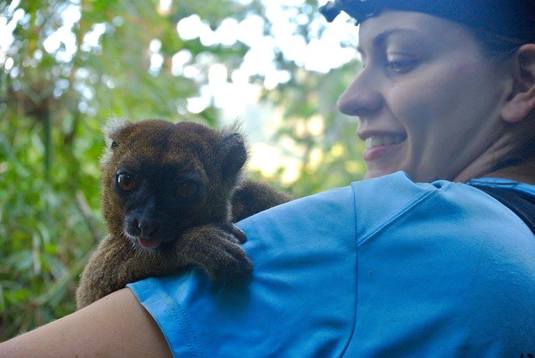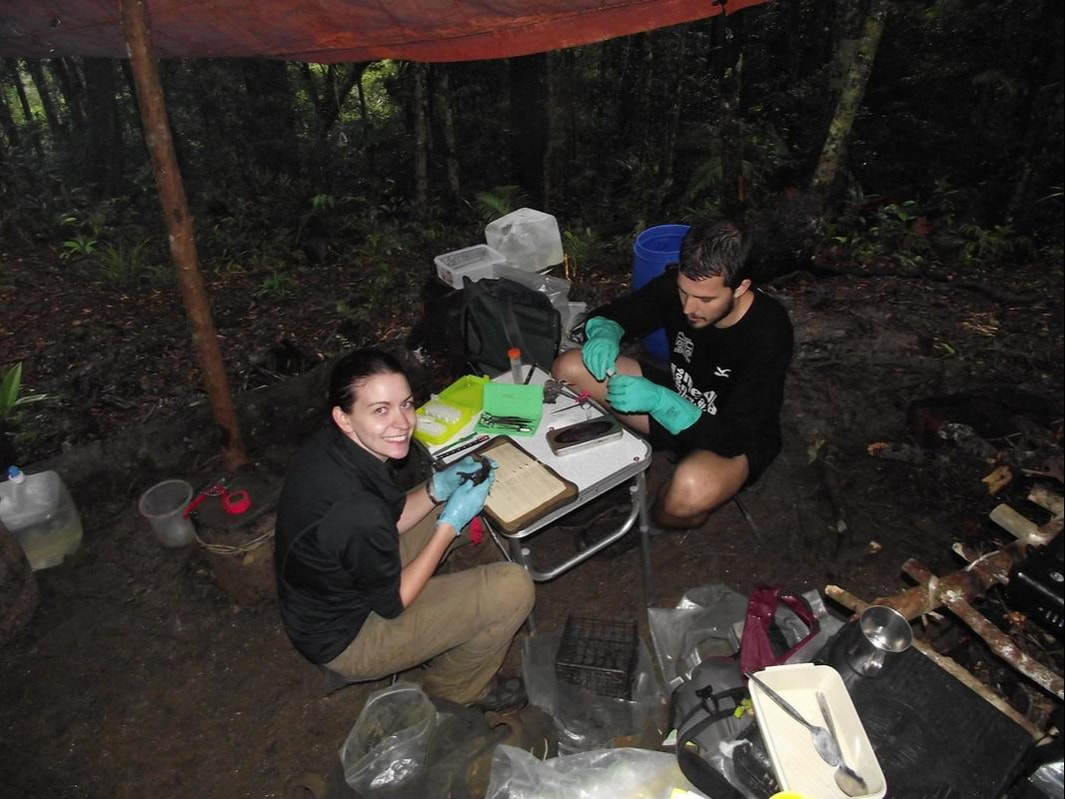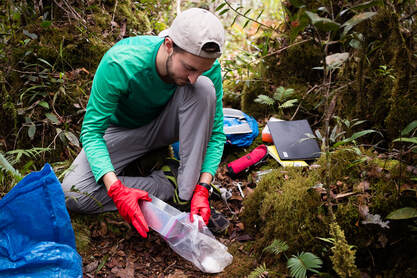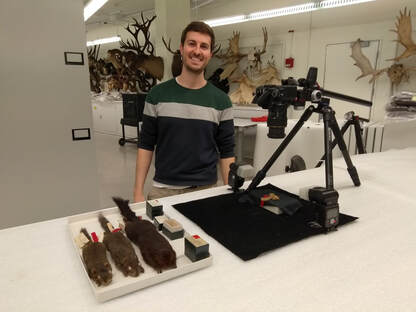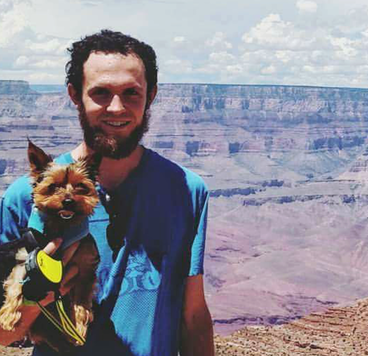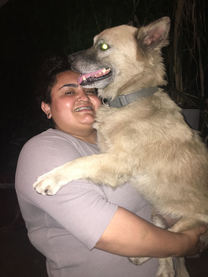Hawkins' Research Lab Members
Melissa Hawkins, PhD
|
Melissa (Missy) holding a sedated Greater Bamboo Lemur doing a routine VHF collar change in Kianjavato, Madagascar. All animal handling was done under proper scientific approval and permissions.
Missy and Miguel Camacho-Sanchez working in a field camp in Borneo in 2012 on Mount Tambuyukon.
|
Postdoctoral Fellows:
Dr. Arlo Hinckley Boned |
am a Margarita Salas postdoctoral fellow that joined the Hawkins lab in 2022. My main interest lies in the study of the evolutionary origin, maintenance and distribution of biodiversity, particularly of tropical small mammals, with the aim to generate knowledge that promotes their conservation. My postdoctoral research at the Smithsonian focuses on the systematics of the pale giant squirrel (Ratufa affinis), a strictly arboreal species widespread throughout Sundaland, making the study of its evolutionary history key to understand this region’s paleo-forest distribution and connectivity dynamics. Unfortunately, the challenges associated with live trapping these high canopy species and obtaining fresh tissue samples has prevented the study of their evolutionary history. Fortunately, historical specimens and the advent of Next Generation Museomics have now enabled the possibility to study their evolutionary history. In order to achieve such goal we plan to use genomic data from museum specimens of all recognised subspecies of R. affinis from Sundaland to construct a well-resolved, dated phylogeny in this region. In addition, morphological data based on pelage coloration, traditional skull morphometrics and bacula μCT scanning will be integrated in order to re-evaluate taxonomic diversity in this group. In my thesis, which I defended at the University of Seville and conducted at the Estación Biológica de Doñana-CSIC, I combined genomic (mitochondrial genomes and nuclear loci from High Throughput Sequencing) and morphometric data collected during expeditions to Bornean mountains and from museum specimens in order to evaluate the role of geological and environmental changes in the diversification of small mammals in Tropical East Asia. In my free time I enjoy outdoor activities (kayaking, hiking, and snorkelling) and playing badminton.
|
Former Students:
Alexa Wimberly
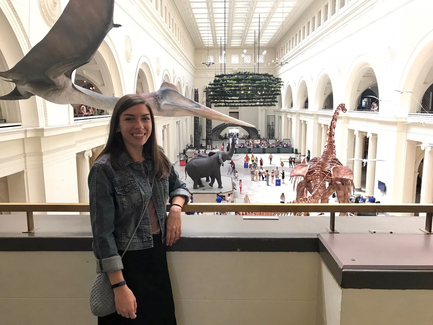
I am a fourth year PhD candidate at the University of Chicago currently engaged in a year-long predoctoral fellowship at the Smithsonian co-hosted by Dr. Melissa Hawkins (Vertebrate Zoology) and Dr. Matthew Carrano (Paleobiology). I am most interested in functional morphology and locomotor diversity in mammals. My dissertation seeks to understand the association between environmental change and locomotor adaptation across time and space in Ruminantia, a diverse clade of terrestrial artiodactyls including deer, antelope, and giraffes. The first section of my dissertation aims to establish how linear measurements throughout the postcranial skeleton predict body mass and habitat preference. The second part will use that information to quantitatively examine trends in locomotor evolution and ecology for extinct North American ruminants, particularly how the shift from dense, forested environments to open grasslands impacted how ruminants navigated their physical environment. In my free time I enjoy thrift shopping, visiting museums and zoos, spending time outdoors, and coming up with puns.
Stella Yuan, B.S., B.A., M.S
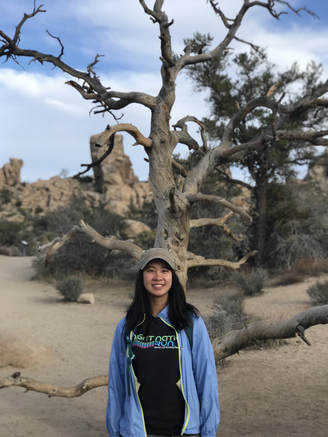
I am a master’s student that joined the Hawkins Lab in 2018. I earned a B.S. in Environmental Systems (Ecology, Behavior, and Evolution) and a B.A. in Psychology in 2017 from the University of California, San Diego. During my undergraduate studies, I pursued a senior's thesis as an internship with the U.S. Fish and Wildlife Service, evaluating the presence and absence of San Bernardino flying squirrels in relation to various habitat parameters. The goal was to better understand the population ecology of the flying squirrels for conservation planning.
After graduation I also spent a few months working as a wildlife intern at Point Reyes National Seashore with the National Park Service, monitoring the Tule Elk, Spotted Owl, and Western Snowy Plover populations. My previous experience and coursework in ecology and evolutionary biology have prompted my research interests in conservation biology, and how genetic diversity, and thus biodiversity in the long run, can be better preserved. I am also just broadly interested in the evolution of isolated, small or declining populations.
Stella defended in April 2020, and her thesis explored the genetic diversity in the Humboldt's flying squirrel, with a focus on the San Bernardino subspecies. The methodology used for this paper is now published, and the main article is in revision at the Journal of Mammalogy. Stella is currently a PhD student at UCLA under Dr. Bob Wayne.
After graduation I also spent a few months working as a wildlife intern at Point Reyes National Seashore with the National Park Service, monitoring the Tule Elk, Spotted Owl, and Western Snowy Plover populations. My previous experience and coursework in ecology and evolutionary biology have prompted my research interests in conservation biology, and how genetic diversity, and thus biodiversity in the long run, can be better preserved. I am also just broadly interested in the evolution of isolated, small or declining populations.
Stella defended in April 2020, and her thesis explored the genetic diversity in the Humboldt's flying squirrel, with a focus on the San Bernardino subspecies. The methodology used for this paper is now published, and the main article is in revision at the Journal of Mammalogy. Stella is currently a PhD student at UCLA under Dr. Bob Wayne.
Clare O'Connell
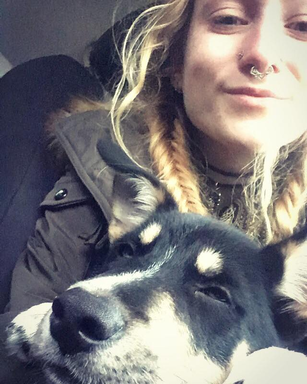
I am an undergraduate Zoology major studying at Humboldt State University, scheduled to graduate in the spring of 2019. My primary study interests revolve around mammals and I plan to undertake genetic research of carnivores in the coming year.
Clare transferred to New Mexico State University to continue her work on the ecology of chipmunks under Dr. Jennifer Frey.
Clare transferred to New Mexico State University to continue her work on the ecology of chipmunks under Dr. Jennifer Frey.
Phil Robinson |
I am an undergraduate Zoology major at Humboldt State University. I am interested in terrestrial mammals, particularly primates and their evolution. Before moving to Humboldt County, I worked as an intern in the primate department at the Houston Zoo. After graduating, I plan on working in the local area and later attending graduate school.
|
Veronica Pina- Aguilar |
I am an undergraduate Zoology major at Humboldt State University, scheduled to graduate in Spring 2019. My primary interests are behavior and conservation of terrestrial mammals. After graduation, I plan on pursuing degrees in Registered Veterinary Technology at Pierce College (Woodland Hills, CA) and Exotic Animal Training and Management at Moorpark College (Moorpark, CA). On my spare time, I enjoy playing basketball, spending time with my friends or simply enjoying the company of my dogs.
|
Aaron Tacub |
Hello! Currently as an Undergraduate Zoology major with a minor in Biological Anthropology, I have found my passions and interests of genetics and evolution within the realm of mammals, but primates especially. I will be graduating this Spring 2019 semester. After graduation, I hope to do service for Americorps' programs in the Southern California area, where I will do up to one to two years of service under mentoring, advising, and leadership programs. The plan is to attend Graduate School and obtain a Master's Degree in Student Affairs, helping other STEM / Science related majors in college by being their advisor or mentor. I hope to continue the momentum of 'Science Communication Practitioner' as this new field of work continues. |
Michael Kiso
Jack Lemke
